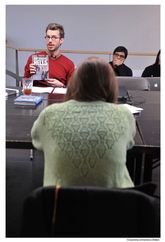Introduction by Jeroen Peeters
Unfortunately, Marianne Van Kerhoven could not be present at the salon. Jeroen Peeters introduced some of her thoughts on collaboration that inspired the salon and framed them with a brief discussion of recent books on participatory art by Claire Bishop and on collaboration as a craft by Richard Sennett.
“Following the collapse of ideologies, we need, I think, people who above all develop practices together. This requires a much more direct responsibility - agreeing with new manifestos is not enough. I sense a hunger among artists to learn more about how people in all areas of society organise their work, how they produce, explore and develop things that may contribute to the ‘reconstruction’. By the same token, artists want to open up their practices to share them with others.” (Marianne Van Kerkhoven in Listen to the Bloody Machine, 2012)
“The urgency of this social task has led to a situation in which socially collaborative practices are all perceived to be equally important artistic gestures of resistance: there can be no failed, unsuccesful, unresolved, or boring works of participatory art.” (Claire Bishop in Artificial Hells, 2012)
“Modern society is ‘de-skilling’ people in practising cooperation. (…) We are losing the skills of cooperation needed to make a complex society work.” (Richard Sennett, Together, 2012)
Talk by Sara Manente
Choreographer and performer Sara Manente discussed several projects: her choreographic works Lawaai means hawaai (2009) and Faire un four (2011), the Bains Connective thematics Come Together (2012), the collaboration with Marcos Simoes This place (2012), and the artistic cooperation Rita by Cabra vzw.
What practice and collaboration do we need to work on a certain topic? Is practice a tool, a ritual, or a training?
The discussed text by Lilia Mestre on Come Together is available here.
The discussed text by Rita is available here.
Talk by Anna Rispoli
How do we organize work and spend our time? In her project Casting Out the Nines/Spending it and Casting Out the Nines/Paying it back, performance artist Anna Rispoli approached this question via LETS (Local Exchange Trading Systems). Alternative monetary systems were discussed on stage, but also created a different productional and temporal frame for collaboration, as well as an altogether different relation with the arts centre STUK, which produced the work for its Artefact festival in Spring 2012.
Anna Rispoli’s discussed essay in Rekto:verso is available in English here.
Talk by Michiel Vandevelde
Choreographer and performance artist Michiel Vandevelde concluded the salon with some general reflections on developing practices together. Is change possible without conflict? Can collaboration have a right in itself beyond the exchange of expert knowledge? How and why did we lose the culture of working together?
Michiel Vandevelde discussed an excerpt (the conclusion) of Adam Curtis’ documentary The Trap - What Happened to Our Dream of Freedom? Part II: The Lonely Robot (2007):
After a meandering audience discussion, the following words by Marianne Van Kerkhoven were read by way of ending:
“The processes that lead to stage activities are almost always the result of a collective practice with a limited group of people: designing and performing the work are closely connected; there is direct personal communication between everyone involved in the project; everyone can more or less create an idea of the work as a whole, and in that way retain a connection with it.” (Marianne Van Kerkhoven in Listen to the Bloody Machine, 2012)



